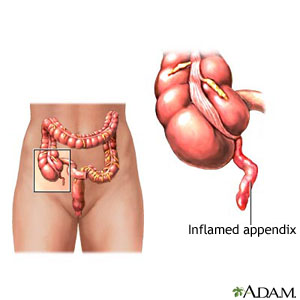WHAT YOU NEED TO KNOW: What is appendicitis? Appendicitis is inflammation of your child's appendix. The appendix is a small pouch. It is attached to the large intestine on the lower right side of the abdomen. The appendix may get blocked by food or by part of a bowel movement that becomes hard. It can also become infected with bacteria or a virus. Appendicitis can also be caused by a parasite or tumor. Your child will need immediate care to prevent a ruptured appendix. A ruptured appendix can cause bacteria to flow into the abdomen. This can lead to a serious infection called peritonitis. 
|
What are the signs and symptoms of appendicitis? The most common symptom is pain that starts at the belly button and moves to the right, lower side of the abdomen. The pain worsens when your child touches his or her abdomen, moves, sneezes, coughs, or takes a deep breath. Appendicitis may be difficult to recognize in young children. Your young child may cry constantly or not want to be held or moved. Your older child may be able to tell you about any symptoms. Your child may also have any of the following: - Swelling in the abdomen (most common in infants)
- Abdomen that feels hard or tender
- Diarrhea or constipation
- Loss of appetite
- Nausea or vomiting
- Fever
How is appendicitis diagnosed? Your healthcare provider will examine your child and check for pain or tenderness in the abdomen. Any of the following may also be needed: - Blood tests may be used to check for signs of infection or inflammation.
- A urine test may be used to check for a urinary tract infection or kidney stone.
- CT or ultrasound pictures of your child's abdomen may be used to check the appendix. Your child may be given contrast liquid to help the appendix show up better in the pictures. Tell the healthcare provider if your child has ever had an allergic reaction to contrast liquid.
How is appendicitis treated? - Medicines may be given to fight an infection or to manage pain. These medicines will be given in the hospital through an IV.
- Drainage may be needed if your child develops an abscess after a burst appendix. To drain the abscess, your child's healthcare provider guides a tube through the skin and into the abscess. Infected fluid drains through the tube.
- An appendectomy is surgery to remove your child's appendix. The appendix may be removed through small incisions in your child's abdomen. If your appendix has burst, your child may need an open appendectomy. A single, larger incision is made to remove the appendix and clean out the abdomen.
When should I seek immediate care? - Your child has a fever.
- Your child has severe abdominal pain.
- Your child is vomiting and cannot keep food down.
When should I contact my child's healthcare provider? - Your child has abdominal pain that does not go away, even after taking pain medicine.
- Your child has chills, a cough, or feels weak and achy.
- Your child has trouble having a bowel movement, or has diarrhea.
- You have questions or concerns about your child's condition or care.
|